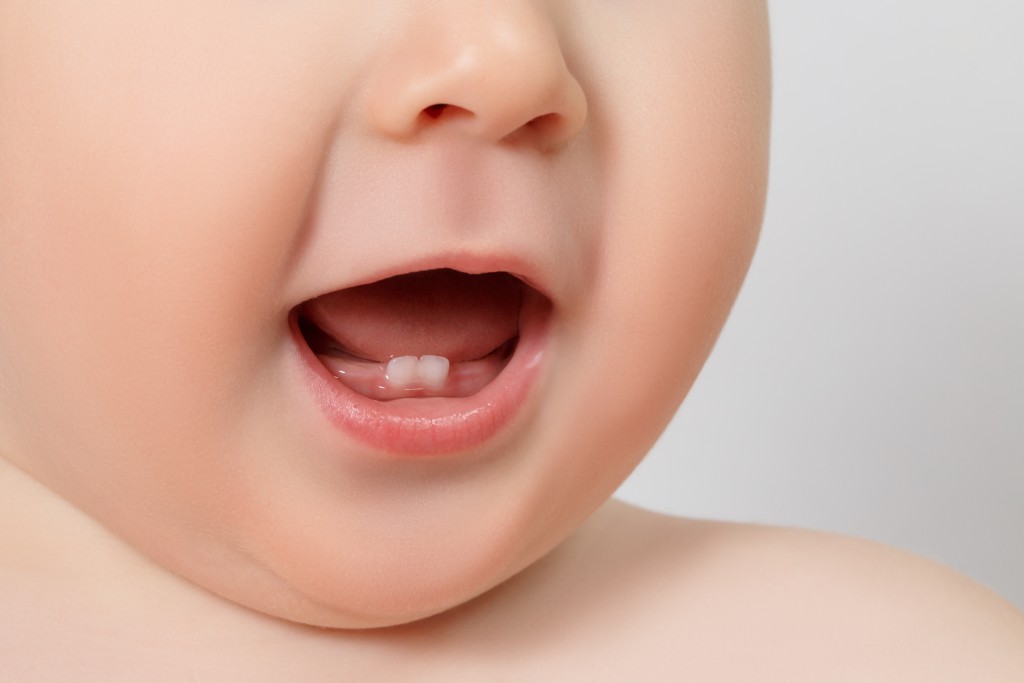Tooth growth in children
Tooth growth begins in babies usually from the fifth to the seventh month. In General, the passes to break Through the milk-teeth without any complications. It is Accompanying symptoms such as pain in the gums, slight fever, loss of appetite and General malaise, however, occur frequently. For parents, this usually means little sleep and a stressful time. In order to facilitate the children of the teething, there are numerous natural remedies, the complaints to the tooth can relieve growth.
Table of contents
Quick help with an aching Tooth eruption
The first tooth fractures in children are often associated with pain. This can be for the Little ones but also for the parent strain. A number of tried-and-tested home remedies can ease this Phase. So, for example, helps around to bite on a chilled teether or chilled carrots or Apple pieces to relieve the pain. Natural means with chamomile and myrrh can be applied to the affected area and gently massaged in. This promotes blood circulation and has anti-inflammatory. The pain should not persist, and can recommend a children’s doctor also pain-relieving ointments.

Tooth growth – a brief Overview
In a unproblematic, for others an ordeal. Tooth growth can sometimes not pose for the child and the parents to be a burden, even if it is a natural process, which is usually the cause for disease. Here is a brief Overview of the tooth growth and the associated possible complaints:
- Definition: tooth growth describes the development of the teeth, the of the plants in the embryonic stage of the formation of the milk teeth to the final development of the permanent dentition ranges.
- Milk-tooth dentition: The milk tooth bite is around the age of three years to complete. It consists of ten teeth in the upper jaw and lower jaw: Four milk incisors, two milk canines, and four milk molar teeth.
- Permanent Teeth: The permanent Teeth of an adult consists of, including the wisdom teeth consisting of 16 teeth in the upper jaw and lower jaw: Four incisors, two canines, four small molars, four large molars and two wisdom teeth.
- Symptoms during Tooth eruption: In the case of babies it is often the case to signs of malaise in the Wake of the tooth due to fracture. It can lead to symptoms such as slight fever, loss of appetite, increased salivation, increased excitability, sleep disorders and rash in the face.
- Diagnosis: The tooth growth is a natural process and usually requires no medical attention. A doctor should periodically monitor the development of the teeth, if necessary, intervene. In the case of acute pain, a child may be referred to a doctor.
- Treatment of breakthrough pain: Chilled teethers, carrots or apples pieces, as well as gum massage with natural remedies from chamomile and myrrh can relieve the pain. A children’s doctor may recommend additional anti-inflammatory or pain-relieving ointments and Gels.
Definition
As tooth growth, the development of the teeth (Odontogenese) of the origin of their plants in the embryonic stage of the training and the breakthrough of the milk teeth to permanent is referred to teeth. Often, the term is relative, however only the milk teeth and the permanent teeth.

The development of the teeth
Tooth growth and development of teeth begins about the sixth week of pregnancy, if in the area of the later upper and lower jaw each have a tooth bar from the oral cavity epithelium. In the further course of the development of the child in the mother’s womb, the milk teeth, are developed within the first two to three years of life to break completely and form through different stages gradually. Usually the externally visible section of the tooth will begin growth with the first two teeth in the lower jaw. All milk teeth are present, the infant each ten teeth in the upper jaw and the lower jaw, which are replaced at the age of six to nine years gradually by permanent teeth. This process runs in two phases: In the first Phase (six to nine years), the first permanent teeth behind the milk teeth. The milk teeth fall out gradually, and the lateral and Central incisors break. In the second Phase (nine to twelve years) first of all, a breakthrough of the canines and the premolars (cheek teeth that have a milk tooth predecessors). Then the other big jaws teeth break through. The breakthrough of the wisdom teeth, the last permanent teeth that is made only from the 18. Years of age.
The Children’s Teeth
The milk-tooth dentition consists of 20 teeth and is usually developed at the age of two to three years. It contains ten teeth in the upper jaw and the lower jaw – four milk incisors, two milk canines, and four milk teeth (molars) to bake. Typically break through after about six months, as first the lower incisors. A little later the upper. If the child is around 18 months old, the first milk canines. From this age, or two years, the first molars break through often. In most cases, all milk teeth at the age of three years.
From the first to the last Tooth
The following particulars are rather to be understood as experience values, and can be in individual persons, both in the order and of the time very different. This is in most cases not a cause for concern. The growth process should be monitored by regular visits of a doctor, who can intervene in a timely manner, if a failure of development should be available. The following table shows the age at which teeth are expected to break through.
- The six months: The first Central incisors break through.
- The nine months: The lateral milk incisors are visible.
- About 18 months: The first milk canines.
- Between the age of 18. Month and two years: The first milk molar teeth put.
- After the third year of life: All the milk teeth have broken through.
- From the age of six: The first big molar tooth breaks through.
- From seven years ago: The Central incisors are permanent teeth replaced.
- From the age of eight years: The permanent lateral incisors break through.
- From the nine years: The permanent canines, and permanent premolars in the lower jaw, by.
- Ten years ago: The remaining small molar teeth in the upper jaw are visible.
- From the age of eleven: The permanent canines of the upper jaw and the second small molars in the upper and lower jaw.
- From the age of twelve: The second permanent big molars to break through.
- At the age of 15 years: The permanent teeth are fully visible.
- From the age of 18: The wisdom teeth break through. This process can 25 to to. Years or lengthier.

The proper care of the first teeth
The professional Association of child and youth doctors recommends cleaning the first baby’s teeth regularly with a cotton swab, as this can influence the health and growth of the subsequent teeth. Milk teeth have enamel a softer tooth as the permanent teeth are particularly susceptible to caries. Therefore, parents should begin with the dental care of children as early as possible. If four to five teeth have broken through, you should use a special Baby toothbrush for cleaning. Approximately from the age of three, parents can teach their children to brush your teeth. Brushing the teeth should be in the first time of one of the parents supports. This Children’s toothpaste should be used, which either no or only a very low Fluoride content.
Tooth Eruption Symptoms
Normally, the breakthrough and the growth of the first teeth in a child without complications. Often babies who are teething, cranky, and show General signs of malaise, including fever and diarrhea. Parents actions during this time, often on very short nights.
The first signs of the breakthrough of the milk teeth in babies to the fifth to seventh month of life, excessive salivation, and the “Bite” in items. Many children cry more often and show a reddened Bottom. In the mouth the gums appears sore and reddish. Fever or Fever, vomiting, and diarrhea with abdominal pain may also be added, where strong symptoms hang in, as a rule, directly with the Teeth together, as this is a natural growth process and not a disease.
Diagnosis of problems with teeth growth
Parents find that your Baby while suffering through a break-up of the teeth of accompanying complaints, is usually a visit to the pediatrician or medical practitioner is sufficient. A dentist must only be used in rare cases, be consulted, for example, if there are no signs that the milk teeth show, and may already be in the system of teeth developmental disturbances have occurred, or the first teeth appear unusual or sick.
In the study, first, the oral cavity of the child will be reviewed and, if necessary, carefully sampled. In addition, questions are asked to the exact complaints, a other cause of the problems. Doubts as to the complete formation of the milk teeth, consist of an x-ray image can provide information on tooth growth in the upper and lower jaw.

Treatment options for tooth growth
In the case of the most common complaints, in which babies suffer during Tooth development, such as Tooth or gum pain and General malaise, home remedies and natural remedies are very effective. A cool teething ring soothes the pain in the mouth. Natural means with chamomile and myrrh also have anti-inflammatory and can be sprinkled on the affected areas and then gently massaged. In this way, the blood circulation in the gums is encouraged, and the Tooth eruption is facilitated. To massage the gums, can chew the children on a carrot or dry bread.
Regular checks for the prevention
The Directive of the Federal Joint Committee for the early detection of diseases in children, regulates the ten screening tests, which should be made in the first six years of life by default. According to the Directive, the first control of the teeth should take place in the framework of the U5-investigation that takes place between the fifth and eighth month of life. From this point on, each of the following Standard screening test (i.e., U6, U7, U7a, U8 and U9) should include an inspection of the teeth.
What you can try also
The following tips are not scientifically proven, but are used often. So amber stone necklaces stone healing will help the customer also in case of tooth pain, by releasing minimal amounts of succinic acid to the skin and the healing of the wound, as well as in the control of infections to accelerate. In homeopathy, depending on the type of the accompanying discomfort during the Teething, among other things, Chamomilla, Kreosotum (especially in diarrhoea), Magnesium phosphoricum, Calcium phosphoricum, Belladonna and Podophyllum (especially in the case of diarrhea). (ag; vb; updated on 24. December 2018)
Sources
- Internet presence of the professional Association of child and youth doctors (bvkj.); visited on 17. December 2018
- Website of the kassenärztliche Bundesvereinigung (KZBV); visited on 17. December 2018
- Directive of the Federal Joint Committee for the early detection of diseases in children (booth 19. October 2017)





